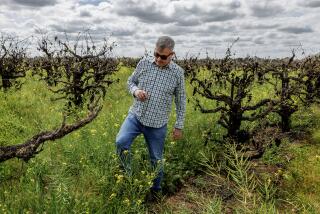Everyday Affordability
In the south of France, wine is viewed as an everyday beverage. At local cafes, you can get a glass of decent wine to accompany your lunch for pennies. Usually it is made by a local vigneron from local grapes and made to be consumed within three years of the harvest.
These are wines of charm and accessibility. Made from Noble grapes, the wine is aged not in oak barrels, but in large vats. But production techniques are better than ever, and the wines are remarkably affordable.
This was what intrigued Peter Mahan in the mid-1980s. The same thing intrigued Martin Sinkoff. They did not know each other, but what they sought was wine that could offer excellent value for the dollar.
American wineries once made such wines, generic blends that sold for $1.99 to $2.99 per bottle. But in the last few years, California winemakers have been on a quest for greatness. Egos got in the way of good value; tasty, modestly priced wines were replaced by Cabernet Sauvignons selling for $12 a bottle.
In 1985, Mahan was a sales executive with Wine Warehouse in San Diego. He persuaded his employer to spin him off into a division that would seek out these French value wines. Sinkoff, meanwhile, was with Glazer’s Wholesale Distributors of Dallas, known for its selection of top-quality French wines, particularly great Burgundies. Sinkoff, who had worked at Chateau Prieure-Lichine and speaks French fluently, began scouring southern France to find bargains that made sense to wine lovers on a budget.
What these men were doing wasn’t much different from the work of wine merchants Bob Haas, Kermit Lynch and others. The literally thousands of wineries in France make it possible to find an endless supply of top-rated wine at reasonable prices--if one takes the time to look.
What Mahan and Sinkoff counted on was the better winemaking techniques of the last two decades that have produced wine of surprisingly high quality at low, almost shocking, prices.
Much of this wine once was called Vin de Table, literally, simple table wine. In 1968 the French government certified a higher class for certain “country wines,” called Vin de Pays. These were wines typically “drunk in the place where they were made,” according to author Steven Spurrier in his “Concise Guide to French Country Wines,” ($5.95, Perigee Books).
“When I tasted some of these wines, I was shocked,” Mahan said. “They were better than a lot of California wine that was selling for $7 and $9 a bottle and they were selling in France for 2 or 3 bucks a bottle.”
And there’s a lot of this wine. About four bottles of every 10 produced in France is from the broad Languedoc-Roussillon region, which produces more than 50 million cases of wine a year. The best is excellent and worth investigating.
Sinkoff is importing a line of wines that include some wines designated Reserve St. Martin. These wonderful values are made by a cooperative that has designed a line of wines that Sinkoff helps blend.
“I wanted to keep the regional identity of the wines,” he said. This means some have regional designations that may not be familiar to Americans, such as Corbieres and Minervois. But the wines are excellent and of great value.
Those familiar with Vin du Pays know that most of it is red wine, but the association called Les Vignerons du Val d’Orbieu has made a strong effort in recent years to improve the quality of the white wines, and it shows most impressively with the 1990 Marsanne, a traditional grape of the Rhone. The wine has the creaminess of Chardonnay and a delicate spice character that works well with rich, well-seasoned food.
The 1990 Chardonnay likewise is a fresh and charming wine. The price for these wines is also shocking: $7 each, and some merchants will discount below that.
I was most impressed by the red wines of Val d’Orbieu, especially the Reserve St. Martin Mourvedre, Minervois, ($7), with its ripe, earthy, tobacco-and-plum character and marvelously deep, rich finish. This wine would compete successfully with Rhones that sell for twice the price. It won a silver medal at the recent Dallas Morning News International wine competition.
Another attractive wine is the dry 1990 Reserve St. Martin Rose de Syrah ($7), a light, refreshing wine that is a very dry alternative to sugary blush wines.
Mahan’s import line, after five years of careful selection, now includes 120 different wines, all hand-picked for their style and quality. Among them are a number of remarkable values, including some excellent wines from the Rhone, Corbieres, Beaujolais and Bordeaux.
Wine of the Week
1989 Chateau de Beauregard ($4.65)-- This is probably Peter Mahan’s greatest find, a wine from the Languedoc that is a blend of four traditional Rhone varieties including Syrah and Grenache. The aroma is fresh with light berry notes and the texture is silky and round with excellent fruit and a faint earthy note for complexity. The wine is wonderful to serve with sausage, game and other rich winter foods. It needs no aging, and some restaurants are beginning to feature it as a wine by the glass. Some merchants may carry this wine for less than $4. It is an amazing wine for the money.
More to Read
Eat your way across L.A.
Get our weekly Tasting Notes newsletter for reviews, news and more.
You may occasionally receive promotional content from the Los Angeles Times.










